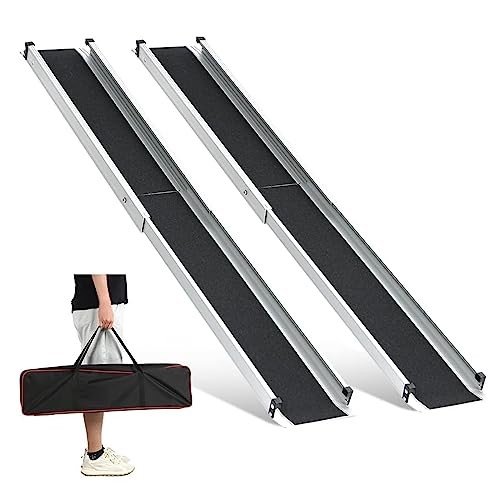
Home Wheelchair Ramps
Add a review FollowOverview
-
Founded Date March 22, 1997
-
Sectors Automotive Jobs
-
Posted Jobs 0
-
Viewed 2
Company Description
Guide To Wheelchair Ramps For Steps: The Intermediate Guide To Wheelchair Ramps For Steps
Wheelchair Ramps for Steps: A Comprehensive Guide
Accessibility is a vital element of modern design, as it ensures that everyone, no matter physical capability, can access structures and public spaces. Wheelchair ramps are essential functions that facilitate this access, specifically in environments where steps are present. This blog site post will check out the various kinds of Ramps For Mobility Scooters, their benefits, aspects to think about when selecting a ramp, and regularly asked questions to assist you make informed choices.
Comprehending Wheelchair Ramps
A wheelchair ramp is a likely surface area designed to connect different levels, enabling individuals who use wheelchairs, walkers, or other mobility help to navigate steps safely. They are particularly crucial in commercial and residential settings, where barriers such as stairs can hamper access.
Kinds of Ramps
There are numerous kinds of wheelchair ramps offered, each suited to various needs and environments:
| Type of Ramp | Description | Ideal Use Case |
|---|---|---|
| Portable Mobile Ramps For Wheelchairs | Lightweight and easy to transfer | Temporary access or outside occasions |
| Limit Ramps | Brief ramps developed for door thresholds | Homes with little steps or raised doorways |
| Modular Ramps | Prefabricated ramps that can be configured | Long-term solutions for buildings with multiple levels |
| Solid Ramps | Sturdy long-term installations | Public buildings and commercial spaces |
| Lorry Ramps | Created for loading and discharging lorries | Transporting mobility equipment or individual usage |
Advantages of Wheelchair Ramps
-
Increased Accessibility: Wheelchair ramps provide important access for those with mobility obstacles, guaranteeing they can go into and leave structures individually.
-
Security: By using a safe alternative to steps, ramps assist prevent accidents that can take place when browsing stairs.
-
Enhanced Independence: With a wheelchair ramp, users can navigate locations without assistance, substantially enhancing their sense of autonomy.
-
Regulative Compliance: Many areas have laws requiring public structures to be available. Installing ramps can assist services fulfill these legal requirements.
-
Increased Property Value: Accessibility functions like ramps can make homes more enticing to possible buyers or occupants.
Key Considerations When Choosing a Wheelchair Ramp
Picking the right Wheelchair Ramps For Steps ramp requires careful consideration of numerous factors:
-
Length and Incline: The length of the Metal Ramp For Wheelchair is vital. An advised slope is 1:12 (for every single inch of height, there ought to be at least 12 inches of ramp run). This ensures that the ramp is not too steep.
-
Width: The ramp must be broad adequate to accommodate the wheelchair comfortably. The minimum width is typically 36 inches.
-
Material: Ramps been available in numerous products, consisting of aluminum, wood, and rubber. Aluminum is long lasting and weather-resistant, making it ideal for outdoor use.
-
Weight Capacity: Ensure the ramp can support the weight of the wheelchair and the user. Many ramps have a specified weight limit; choosing one that exceeds anticipated loads is finest.
-
Place: The positioning of the ramp is essential for use. It should lie where it supplies the most access and security.
-
Ease of Installation: Some ramps are portable and need no setup, while others may need expert setup. Think about how typically the ramp will be utilized and who will utilize it.
Ramp Installation
Setup of wheelchair ramps can differ based upon the type of ramp chosen. Portable ramps normally require little to no setup, while modular and solid ramps may need expert installation.

Setup Steps for Modular Ramps:
-
Measure the Access Point: Determine the height of the steps to determine the ramp length needed.
-
Secure Permissions: Ensure you have any needed authorizations or authorizations from your local authorities.
-
Install the Base: Attach the base of the ramp securely to the ground or steps.
-
Put together the Framework: Put together the modular areas according to the manufacturer’s instructions.
-
Look for Stability: Ensure the ramp is stable and securely attached before use.
Frequently Asked Question About Wheelchair Ramps
Q1: Do I need a license to set up a wheelchair ramp?
A: Many municipalities require authorizations for setting up wheelchair ramps, specifically irreversible structures. It’s vital to inspect regional regulations and get the required approvals before installation.
Q2: How do I maintain my wheelchair ramp?
A: Maintenance will depend upon the product. Frequently examine for any damage, clean the surface area to prevent slipperiness, and make certain that any bolts or anchors stay protected.
Q3: How can I ensure the ramp is safe for all users?
A: To make the most of safety, make sure the ramp has a non-slip surface, proper handrails, adequate lighting, and fulfills regional building codes for slope and width.
Q4: Are there grants readily available for wheelchair ramp building and construction?
A: Various government and not-for-profit organizations provide monetary support for ease of access renovations, including wheelchair ramps. Research programs in your location or speak with a local disability advocacy group for info.
Q5: Can I use a wheelchair ramp with other mobility devices?
A: Yes! Most wheelchair ramps are designed to accommodate numerous mobility aids, consisting of walkers, scooters, and strollers.
Wheelchair ramps play an integral role in guaranteeing ease of access for people with mobility obstacles. When choosing and setting up a ramp, different factors ought to be thought about to ensure safety, functionality, and compliance with policies. By offering accessible entryways, businesses and property owners contribute to a more inclusive neighborhood. With the best information and preparation, browsing steps can end up being a seamless experience for everyone.
